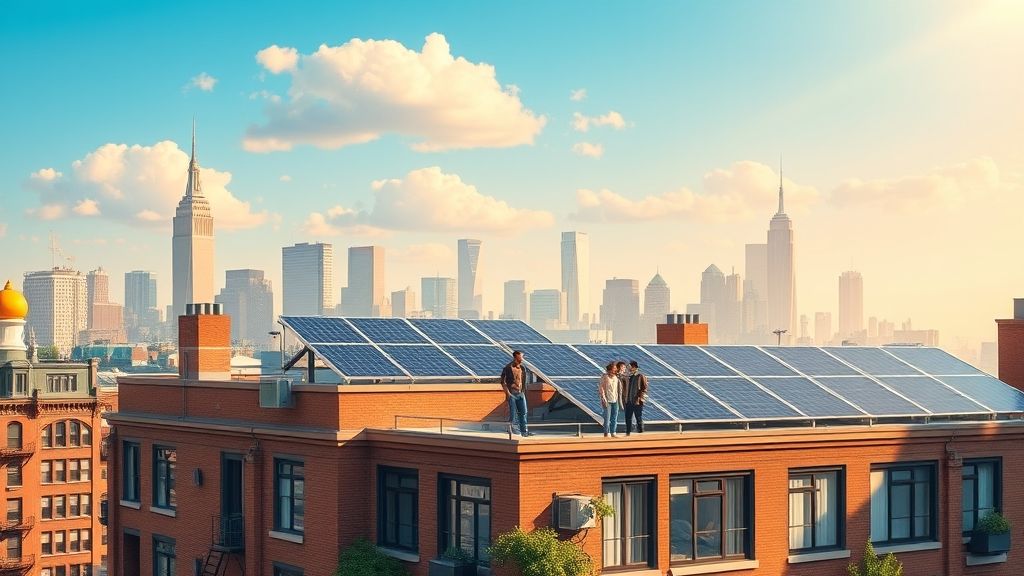New York City’s push toward renewable energy has sparked interest among co-op residents eager to embrace solar power. But with shared ownership models and aging infrastructure, many wonder: can coop get solar panels in nyc? The answer is yes—but navigating the process demands careful planning. This guide unpacks the opportunities, roadblocks, and actionable steps for co-ops ready to harness the sun’s energy.
Why NYC Co-Ops Are Turning to Solar Energy
Beyond reducing carbon footprints, solar panels offer co-ops tangible advantages that align with urban living and financial realities:
1- Long-Term Cost Reduction
Solar systems slash electricity bills by offsetting grid reliance. For large buildings, annual savings can reach tens of thousands of dollars, easing maintenance fees for residents.
3- Energy Resilience
With extreme weather becoming more frequent, solar panels paired with battery storage can provide backup power during outages—a major selling point for city dwellers.
3- Meeting Climate Goals
NYC’s Local Law 97 imposes hefty fines on buildings exceeding emission limits by 2024. Solar installations help co-ops avoid penalties while supporting the city’s target of 100% clean electricity by 2040.
4- Enhanced Market Appeal
Eco-conscious buyers increasingly prioritize sustainable homes. Solar upgrades can boost property values and attract environmentally minded shareholders.
Unique Hurdles for Co-Op Solar Projects
While the benefits are compelling, co-ops face distinct challenges:
-
Collective Decision-Making: Gaining board approval requires consensus among shareholders, which can delay projects if priorities clash. Transparent communication about costs and ROI is critical.
-
Structural Constraints: Many pre-war buildings lack roof reinforcements for solar arrays. Engineers may need to assess load capacity, and retrofitting could add costs.
-
Regulatory Maze: Permitting involves multiple agencies, including the NYC Department of Buildings and Fire Department. Landmarked buildings face additional historic preservation reviews.
-
Upfront Costs: Despite incentives, initial investments can deter cash-strapped co-ops. Creative financing, like power purchase agreements (PPAs), may ease the burden.
A Roadmap for Co-Ops to Go Solar
1- Feasibility Assessment
Hire a solar consultant to evaluate roof condition, sun exposure, and structural limits. Tools like Google’s Project Sunroof can estimate energy generation potential.
2- Community Engagement
Host town halls to educate shareholders on benefits, addressing concerns about aesthetics, noise, or temporary disruptions. Highlight success stories from nearby co-ops.
3- Funding and Incentives
NYC Solar Tax Abatement: Covers 20% of installation costs over four years.
Federal ITC: Offers a 30% tax credit through 2032.
NY-Sun Rebates: Provides cash incentives based on system size.
4- Vendor Selection
Choose contractors experienced with NYC co-ops. Ask for references and confirm licenses (e.g., NABCEP certification). Ensure proposals include maintenance plans and production guarantees.
5- Permitting and Installation
Contractors typically handle DOB filings, electrical permits, and fire code compliance. Expect a 6–12-month timeline from approval to activation.
6- Ongoing Management
Form a sustainability committee to monitor output, manage net metering credits, and schedule cleanings. Many systems include apps for real-time tracking.
NYC Co-Ops Leading the Solar Charge
-
The East River Housing Complex (Manhattan): Installed a 500-panel array in 2023, cutting energy costs by 40% and qualifying for $150k in rebates.
-
Amalgamated Warbasse Houses (Brooklyn): Partnered with a solar cooperative to share costs across five buildings, creating a microgrid for storm resilience.
-
Queens Colony Co-Op: Leveraged PPAs to install solar with zero upfront costs, paying only for the energy generated.
Avoiding Common Pitfalls
-
Underestimating Shading: Nearby skyscrapers or water towers can reduce efficiency. Opt for advanced panels with micro-inverters to mitigate this.
-
Ignoring Maintenance: Dust and debris lower output. Factor in bi-annual cleanings and inverter replacements every 10–15 years.
-
Overlooking Billing Structures: Confirm how net metering credits apply to shared meters. Some utilities prorate savings based on occupancy.
Final Thoughts
For NYC co-ops, solar panels are more than an eco-friendly upgrade—they’re a strategic investment in financial stability and regulatory compliance. While challenges like board approvals and retrofitting exist, the growing availability of incentives and experienced installers simplifies the journey. By taking a collaborative approach and leveraging local resources, co-ops can unlock solar energy’s full potential, setting a benchmark for sustainable urban living.
